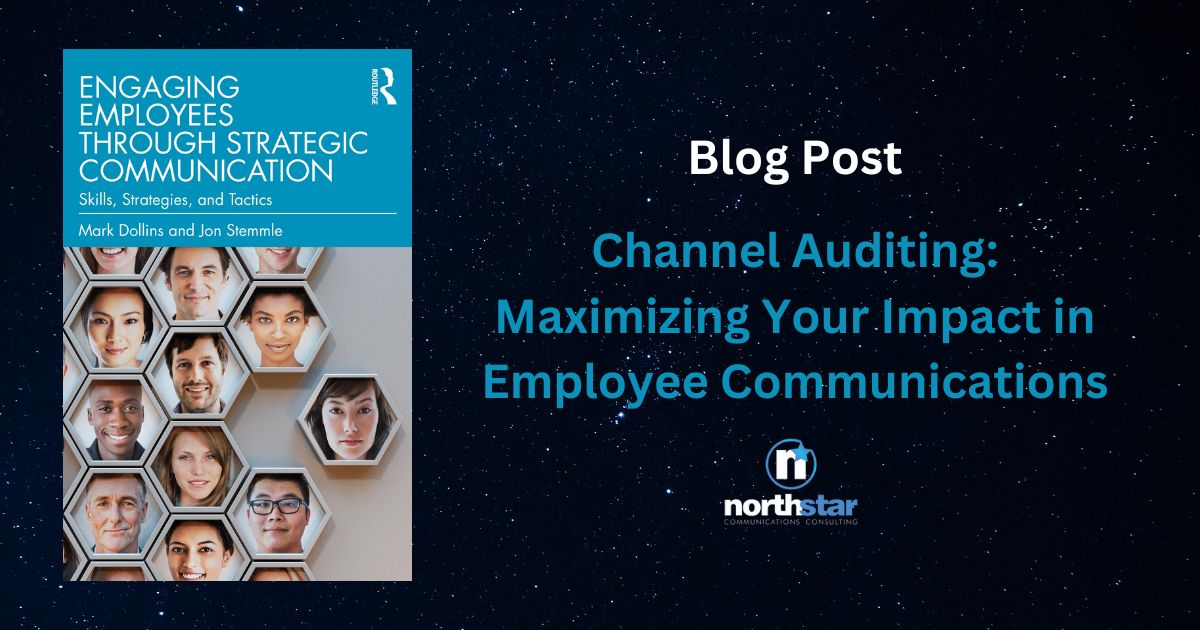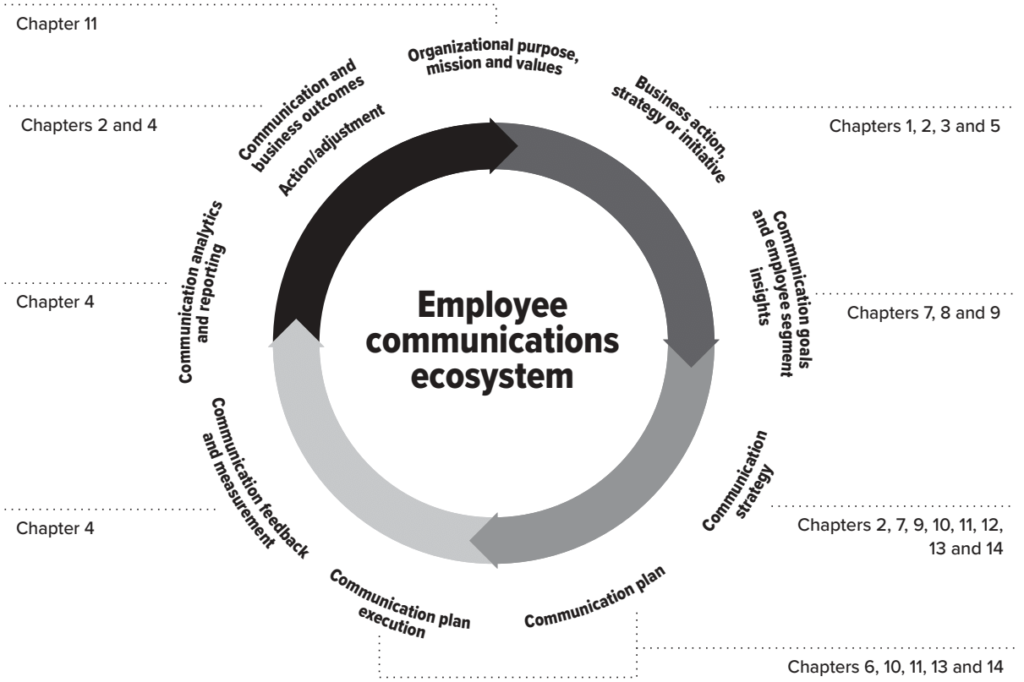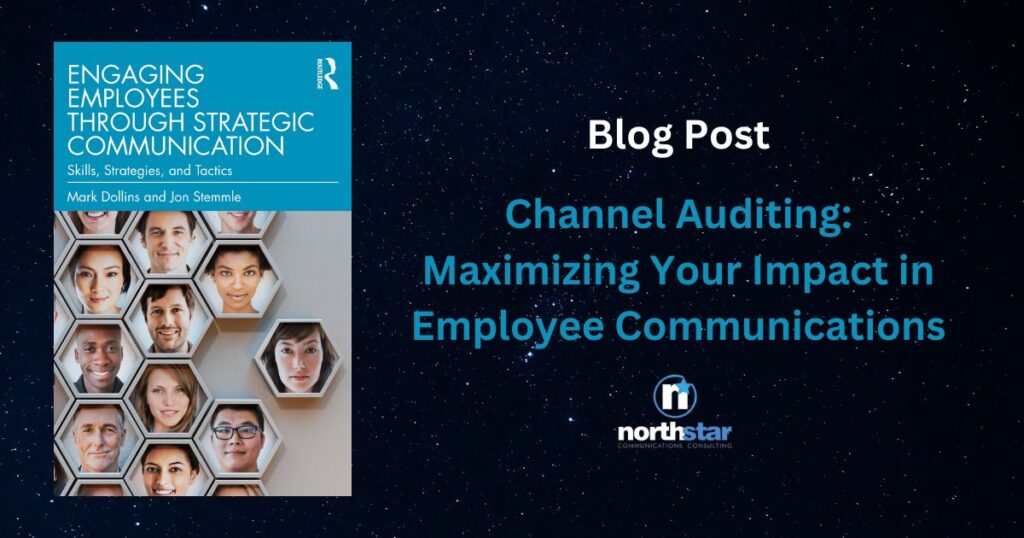
This blog post briefly summarizes Chapter 8 of the book Engaging Employees Through Strategic Communication by Mark Dollins and Jon Stemmle. Visit engage-employees.com to grab your copy today.
Chapter 8 Summary: Channel auditing, Insights and Actions
ECOSYSTEM
As hard as communicators work to get the message right, the ability to effectively and efficiently deliver it can prove to be a far more daunting task. Employees might not hear about significant news in an internal e-newsletter because they had too many emails to slog through or they assumed news that important would be delivered by a manager.
In these, and in many other instances where messaging doesn’t reach — or resonate with — its intended audience, it’s likely that internal communication channels aren’t working. The way to assess why that’s the case is through auditing channels and analyzing data and then acting on those findings to remedy what’s failing.
When we talk about auditing, this isn’t what you’d associate with accounting procedures. Contrary to looking for a specific number that’s missing, or calculation that doesn’t add up, auditing channels deals with examining a host of potential issues — ranging from email list management, to governance for who gets access to what kinds of information, to preferred channels employees have for receiving specific kinds of information. This kind of methodical analysis of the channels used, and assessment of what’s needed, can dramatically improve — and ensure — that the right content is being delivered, in the right channel, to the targeted internal stakeholders.
Auditing isn’t a task that’s independent from delivering business and communication objectives; it’s an enabler of both. With deepening insights into what content is reaching — and resonating with — internal stakeholders, critical audit findings allow communicators to assess everything from how corporate narratives are faring to whether or not social digital platforms are delivering an ROI (and a lot of other things in between).
Conducting an audit
The basics of auditing include collecting samples of all existing internal communications, conducting surveys and focus groups, along with assessing passive metrics and analytics that can come from digital communications — such as open rates and click throughs.
The key is to think, and act, holistically in assessing the world of employee communications. This means not only looking at communications created and delivered from corporate — or centralized — sources, but from channels that exist within operating divisions, lines of businesses, geographic areas and even individual locations.
The reason that communicators need to be comprehensive in their auditing efforts is to ensure they understand where gaps and redundancies exist in content, frequency and cadence; and more importantly, they need to fully understand the employee experience in receiving different messages from different sources — all coming from inside the same organization. In other words, to understand what’s working — and what isn’t — communicators need the full, big picture from the employee’s point of view. Mapping the employee experience is the only way to do that successfully.
The survey: Ground zero
The fundamental tool used for just about every internal communications audit is the survey. While anonymity clearly is a way to encourage direct and candid feedback from survey participants, it doesn’t mean surveys should not include demographic insights.
Asking employees about the kinds of roles they hold, the number of years spent with the organization, what languages they use or need in communications, and what parts of an organization they affiliate with (as covered in Chapter 7) can help research efforts by zeroing in on where, and with whom, communications are not working well. Of course, labor laws in any given country may restrict just how deep it’s possible to go in getting demographic insights, but the more detail that can be collected, the better the resulting strategies will be to address the research findings. This can be particularly helpful with the generational differences of preferred communication channels. From Baby Boomers to Generations X, Y and now Z, increasing preferences for digital communication – and even different types of digital communications — can play a significant role in connecting with them inside an organization.

Source: 2019 Yellow Recruiting https://yello.staging.wpengine.com/resource/white-paper/generation-z-recruiting-study/
Here’s the bottom line: employees want to be heard. In truth, this isn’t groundbreaking news, but it commonly is an area overlooked by employee communicators. There’s often such a focus on driving communications agendas that — sometimes– communicators forget to ask, “Do you feel we’re listening to you?” This is another critical topic on which an audit can yield important insights. If the right questions are asked about whether employees feel empowered to share their thoughts about what the business is doing, it can begin to elevate understanding on how open communications are inside the enterprise. If employees are asked if they feel they have opportunities to share their opinions, and if they believe the company is listening, it aids the creation of a classic tenet of modern day employee communications — building a continuous feedback loop.
Are you interested in learning more about channel insights and turning insights into actions? Pick up a copy of Engaging Employees Through Strategic Communication to read the full chapter.
Get Your Copy Of The Engaging Employees Through Strategic Communication Book Or Contact North Star Communications Today

The diagram above shows the different topics covered in the book. Take advantage of the opportunity to enhance your organizational communication strategy and engage your employees effectively by getting your hands on the highly recommended book, Engaging Employees Through Strategic Communication by Mark Dollins and Jon Stemmle. Piqued your curiosity? Want to know why change communications, Block Chain, Artificial Intelligence and employee activism will shape our near-term future? Visit engage-employees.com to grab your copy today.
If you’re looking for expert guidance in implementing change communications, talent development, and coaching in your organization, look no further than North Star Communications Consulting. Contact us today to schedule a free consultation and take the first step toward transforming your organizational communication approach.


